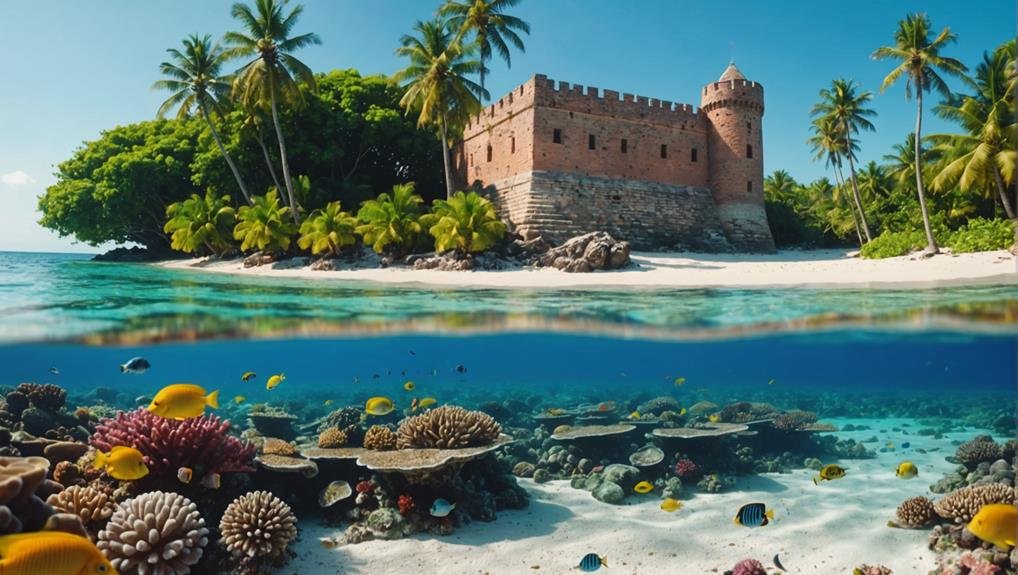If you’re considering a trip to Dry Tortugas National Park, it offers much more than a remote location. Getting there is an adventure whether you choose a boat or a seaplane. Once you arrive, the expansive Fort Jefferson awaits a marvel of masonry and history. But that’s just the beginning.
Imagine snorkeling through vibrant coral reefs or relaxing on secluded beaches. The park’s rich marine life and bird-watching opportunities also promise unique experiences. Curious about what else makes this destination so special? Let’s take a closer look.
Key Takeaways
- Dry Tortugas National Park is accessible by boat or seaplane from Key West.
- Fort Jefferson, the park’s centerpiece, is the largest masonry structure in the Western Hemisphere.
- The park offers excellent snorkeling with vibrant coral reefs and diverse marine life.
- It is a prime birdwatching location, especially for migratory species like the Magnificent Frigatebird and Sooty Tern.
- Limited camping spots are available on Garden Key with necessary reservations.
Getting to Dry Tortugas
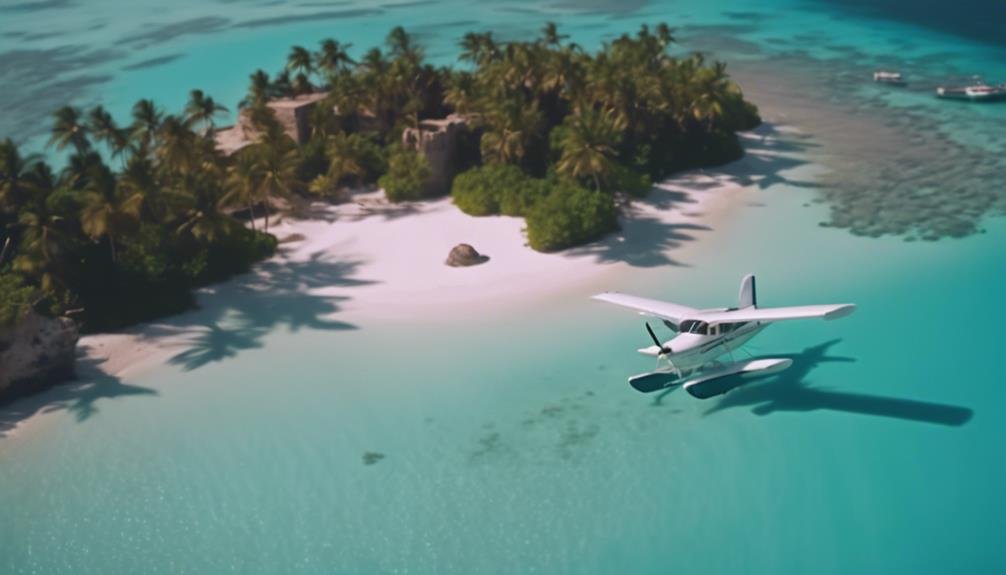
To reach Dry Tortugas National Park, take a boat or seaplane from Key West. The park is nearly seventy miles from the mainland, and the journey is part of the adventure. The Yankee Freedom Ferry is the official transportation service to the park. It offers a comfortable and scenic ride, making it a popular choice among visitors.
The ferry provides all the amenities you’ll need, including restrooms, a snack bar, and informative guides to enrich your experience. If you’re looking to save time, seaplanes are an excellent alternative. These flights take less than 45 minutes and offer stunning aerial views of the turquoise waters and the park’s lush islands.
Most visitors opt for the ferry or seaplane, as there are no other means of reaching this remote destination. Limited camping spots are available on Garden Key for those planning an extended stay. Reservations are a must for this unique experience, though. Whether you choose the leisurely pace of the Yankee Freedom or the quick trip via seaplanes, getting to Dry Tortugas National Park is an unforgettable part of your adventure.
Exploring Fort Jefferson
Once you arrive at Dry Tortugas National Park, exploring Fort Jefferson becomes an absolute highlight. This massive fort, constructed with over 16 million bricks, is the largest masonry structure in the Western Hemisphere. As you wander through the historic Fort Jefferson, you’ll be transported back to the 19th century and gain insights into its significance as a coastal fortress.
The tranquil blue waters surrounding the fort add to its picturesque setting, making it a must-do experience for any history enthusiast. To make the most out of your exploration, consider these activities:
- Guided Tours: Join a ranger-led tour to learn about Fort Jefferson’s rich history. You’ll hear fascinating stories and learn about its strategic importance.
- Self-Guided Exploration: Wander at your own pace, taking in the architectural marvels and reading the informative plaques throughout the fort.
- Photography: Capture the stunning views of Fort Jefferson and the beautiful surrounding waters.
- Bird Watching: The fort is a haven for birdwatchers, offering a unique opportunity to spot rare species in their natural habitat.
Visiting Fort Jefferson in Dry Tortugas National Park is an unforgettable experience, seamlessly blending history and natural beauty.
Snorkeling Adventures
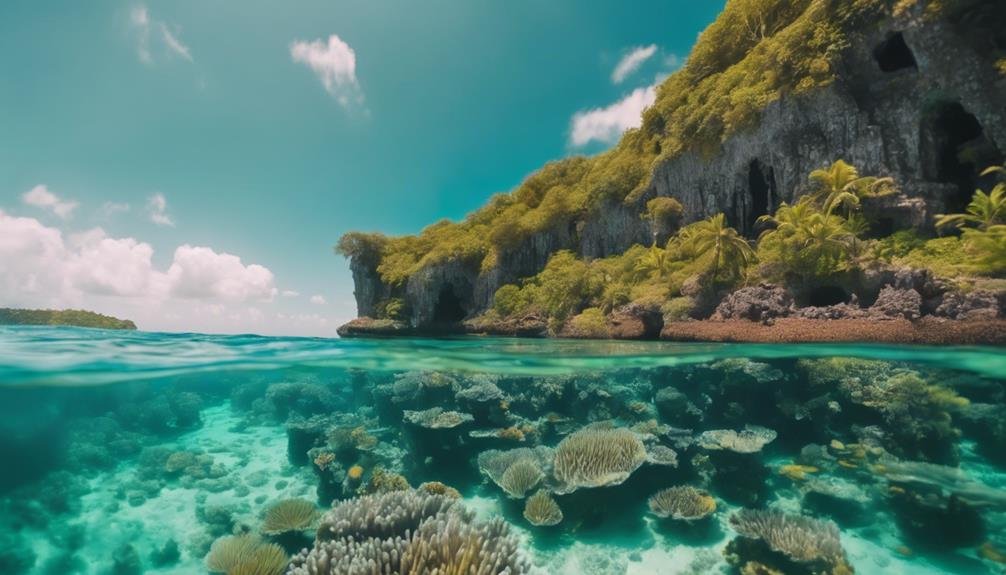
When you’re ready for snorkeling adventures, Dry Tortugas National Park offers vibrant coral reefs teeming with marine wildlife. In the park’s crystal-clear waters, you’ll encounter a variety of fish species, making for unforgettable underwater scenes. Don’t forget your camera; these underwater photography tips will help you capture the magic.
Vibrant Coral Reefs
Imagine immersing yourself in the crystal-clear waters of Dry Tortugas National Park, where vibrant coral reefs teeming with marine life await your discovery. As you snorkel through the shallow waters, ranging from 5 to 15 feet deep, you’ll be mesmerized by the stunning coral formations and diverse marine creatures that call this underwater paradise home. Here are four reasons why snorkeling at Dry Tortugas National Park is an unforgettable adventure:
- Vibrant Coral Reefs: The park’s coral reefs are some of North America’s most colorful and diverse, providing a breathtaking backdrop for your snorkeling experience.
- Abundant Marine Life: You’ll encounter a variety of marine life, including colorful fish, sea turtles, and other fascinating sea creatures that thrive in this pristine environment.
- Clear Visibility: The crystal-clear waters offer excellent visibility, allowing you to fully appreciate the intricate details of the coral formations and the vibrant marine life.
- Accessibility: The shallow waters make it an ideal spot for snorkelers of all skill levels, ensuring that everyone can enjoy the beauty and biodiversity of this unique underwater world.
Snorkeling in Dry Tortugas National Park is an experience you won’t forget. Immerse yourself and explore!
Marine Wildlife Encounters
Exploring the waters of Dry Tortugas National Park, you’ll find yourself immersed in an array of marine wildlife that makes every snorkeling adventure unforgettable. The park’s clear visibility and shallow waters create an ideal environment for spotting colorful fish, vibrant coral reefs, and even sea turtles.
As you snorkel, you’ll be amazed by the diverse species swimming gracefully in their natural habitat. The remote location of Dry Tortugas guarantees a protected marine environment, providing a unique opportunity for up-close encounters with aquatic wildlife. You’ll glide over intricate coral formations, watching schools of tropical fish dart around you.
The rich ecosystem here is a paradise for nature lovers and adventure seekers. Snorkeling in these crystal-clear waters lets you witness the underwater world’s beauty firsthand. Imagine swimming alongside a sea turtle or marveling at the myriad of colors displayed by the coral reefs. Each snorkeling experience reveals something new, making every trip a thrilling adventure.
Underwater Photography Tips
Capturing stunning underwater photos during your snorkeling adventures in Dry Tortugas National Park is exciting and rewarding. To make the most of your underwater photography, consider these essential tips:
- Use Proper Equipment: Ensure you have a waterproof camera or underwater housing to protect your gear. This will allow you to capture high-quality images without worrying about water damage.
- Leverage Natural Light: The best lighting conditions for underwater photography are during the golden hours of sunrise and sunset. Natural light enhances the vivid colors of coral reefs and marine life, making your photos more vibrant.
- Get Close, But Be Respectful: Get close to your subjects for clear and detailed shots. However, always avoid disturbing marine life or damaging the delicate coral reefs. Respect the underwater environment to preserve its beauty.
- Experiment with Angles: Try different angles, perspectives, and compositions to add depth and interest to your photos. This can highlight the diversity and splendor of the underwater world in Dry Tortugas.
Additionally, practice good buoyancy control to stay steady while shooting, and consider using a red filter to enhance colors in your images. With these tips, you’ll capture breathtaking underwater photos you’ll cherish forever.
Secluded Beaches
The secluded beaches of Dry Tortugas National Park are a tranquil paradise, perfect for escaping the crowds. Located 70 miles west of Key West, these pristine beaches boast crystal blue waters, swaying palm trees, and soft, powdery sand. They offer an ideal setting for swimming, sunbathing, and shore strolling.
The remote location guarantees a peaceful retreat far removed from the hustle and bustle of everyday life. The secluded beaches are a dream come true for snorkeling enthusiasts. The shallow waters and abundant marine life make this park a top destination for underwater exploration.
You can easily spot vibrant coral reefs, colorful fish, and other marine creatures with clear visibility. Whether you’re a seasoned snorkeler or a beginner, the underwater world here provides an unforgettable experience.
The serene environment and natural beauty of Dry Tortugas National Park’s beaches make it the best beach destination in the Florida Keys. So, pack your gear and get ready to immerse yourself in the tranquil waters and mesmerizing marine life that await you at these secluded beaches.
Bird Watching
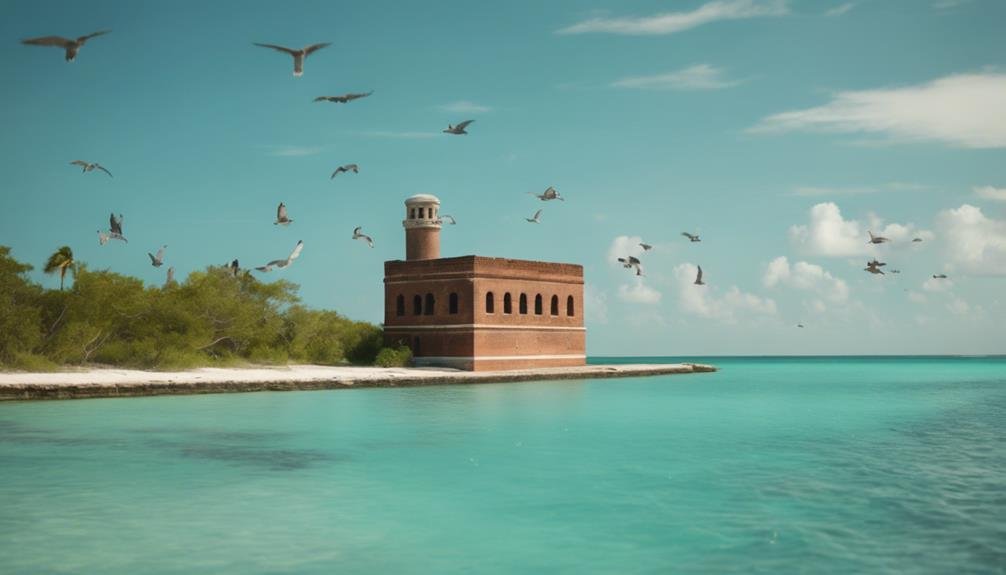
When you visit Dry Tortugas, you’ll find it an essential stopover for migrating birds traveling between South America and the U.S. Explore the seven tiny islands to spot various bird species in their natural habitat. For the best birdwatching experience, head to the ideal viewing locations that make this park a highlight of the Great Florida Birding Trail.
Migratory Bird Species
Birdwatching in Dry Tortugas National Park offers an unparalleled opportunity to observe many migratory species as they make their crucial stopover between South America and the U.S. The park’s unique location and seven tiny islands create a haven for bird enthusiasts.
Here, you can witness diverse migratory bird species in their natural habitat, making it a prime destination for those passionate about birdwatching. During your visit, you’ll encounter a variety of fascinating migratory birds. These species depend on the park’s rich resources to replenish and rest. Some key highlights include:
- Magnificent Frigatebird: Known for its impressive wingspan and striking appearance, this bird is often seen soaring above the islands.
- Sooty Tern: These seabirds are known for their distinctive calls and nest on the park’s sandy shores.
- Black Noddy: A rare sight in North America, these birds typically roost on the park’s structures.
- Brown Booby: Easily recognizable with their brown and white plumage, they often plunge into the waters surrounding the islands.
Dry Tortugas National Park truly offers a once-in-a-lifetime birdwatching experience, allowing you to witness the incredible journeys of these migratory bird species.
Optimal Viewing Locations
For the best birdwatching experiences in Dry Tortugas National Park, head to specific vantage points that offer excellent viewing of the migratory species. One of the top spots is Garden Key, where Fort Jefferson stands. The fort’s walls and surrounding area create ideal observation points for spotting various bird species, especially during migration seasons.
Loggerhead Key, the largest island in the park, also offers outstanding birdwatching opportunities. Its diverse habitats attract numerous bird species, providing a rich birdwatching experience. Walk along the beaches and trails to see frigatebirds, terns, and even the elusive masked booby.
Bush Key is another prime location known for its nesting colonies of sooty terns and brown noddies. The island is closed to visitors during nesting season, but you can still observe the birds from a distance, making it a must-visit for any bird enthusiast.
Dry Tortugas National Park’s strategic location along bird migration routes offers unparalleled opportunities to observe and appreciate diverse birdlife. Whether you’re a seasoned birder or a novice, the park’s islands are an exceptional birdwatching destination.
Camping Experiences
Camping at Dry Tortugas National Park offers an unparalleled opportunity to connect with nature on Garden Key. Situated 70 miles from civilization, you’ll be surrounded by warm tropical breezes and swaying palm trees. With only eight primitive campsites, the park provides a truly unique camping experience.
Due to the limited number of spots, you must make advanced reservations to secure your place in this remote paradise. While camping at Dry Tortugas National Park, you must be self-sufficient. Here’s what you should bring:
- Food and Water: Garden Key lacks facilities, so pack enough to last your entire stay.
- Camping Gear: Ensure you have a sturdy tent, sleeping bag, and other essentials.
- Cooking Supplies: Bring a portable stove and utensils, as open fires aren’t allowed.
- Waste Management: Carry out all trash to keep the park pristine.
Park History
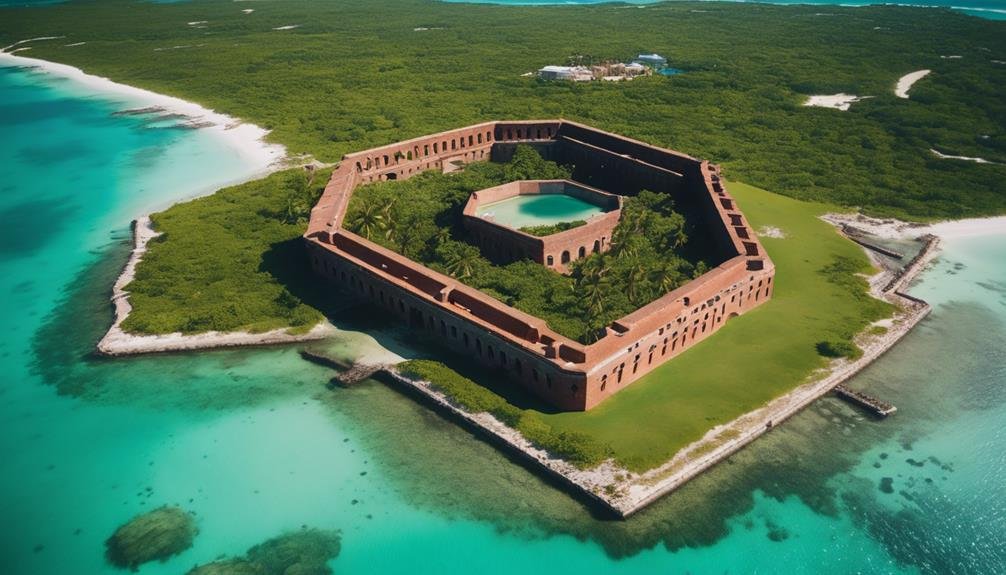
You’ll find the park’s history fascinating, starting with Juan Ponce de León‘s visit in 1513, marking the early exploration era. Fort Jefferson’s construction began in 1846, becoming the largest masonry structure in the Western Hemisphere. These events set the stage for the park’s strategic role in controlling the Straits of Florida and the Gulf of Mexico.
Early Exploration and Discovery
Juan Ponce de León’s visit in 1513 marked the beginning of European exploration in what’s now Dry Tortugas National Park. This early exploration was significant due to the island’s strategic location, crucial in controlling the Straits of Florida and the Gulf of Mexico.
As you explore the park’s history, you’ll discover that the National Park Service has preserved a rich tapestry of maritime heritage and early discoveries. When you investigate Dry Tortugas, keep an eye out for these fascinating historical aspects:
- Shipwrecks: Numerous shipwrecks in the area highlight the dangerous nature of early sea voyages and the importance of the islands in maritime navigation.
- Explorers’ Accounts: Early explorers, including Ponce de León, documented their encounters and findings, providing invaluable insights into the region’s past.
- Maritime Artifacts: Items salvaged from the sea offer a glimpse into the lives of those who navigated these waters centuries ago.
- Cultural Impact: The strategic importance of the Dry Tortugas influenced various European powers, shaping the cultural landscape of the Florida Keys.
Fort Jefferson Construction
Fort Jefferson began construction in 1846 and is a significant feat of 19th-century military engineering in Dry Tortugas National Park. Situated on Garden Key, the fort was strategically designed to control naval access to the Gulf of Mexico and protect important shipping lanes.
Fort Jefferson’s construction took over 30 years and used more than 16 million bricks, making it the largest masonry structure in the Western Hemisphere. The fort’s design and location provided an essential vantage point for monitoring maritime activities, underscoring its strategic importance.
Throughout its extensive construction period, the fort showcased impressive military architecture, reflecting the advanced engineering techniques of the time. Despite never being fully completed, Fort Jefferson played a notable role in U.S. history. During the Civil War, it served as a Union military prison, adding a layer of historical significance to its already impressive structure.
When you visit Fort Jefferson today, you can marvel at the sheer scale and craftsmanship that went into its construction. It reflects the ambitions and challenges of 19th-century military fortifications, offering a unique glimpse into a pivotal era of American history.
Marine Life
Explore the vibrant underwater world of Dry Tortugas National Park, where you can immerse yourself in an astonishing array of marine life. The park’s crystal-clear waters are perfect for snorkeling, offering a front-row seat to colorful coral reefs and tropical fish.
You might even spot graceful sea turtles gliding through the water. Marine life is abundant and varied here, making every snorkeling adventure unique. When you immerse yourself in these waters, you’ll find:
- Coral Reefs: Underwater gardens of brain corals, elkhorn corals, and sponges provide habitats for countless marine organisms.
- Tropical Fish: Witness species like parrotfish, angelfish, and moray eels as they navigate the reefs.
- Larger Marine Creatures: In the park’s shallow waters, look for nurse sharks, barracudas, and octopuses.
- Biodiversity: With over 200 species of fish and 30 species of corals, the park offers a unique chance to observe and appreciate marine biodiversity up close.
The excellent visibility in these shallow waters makes it easy to spot these fascinating creatures. Snorkeling in Dry Tortugas National Park is a must-do experience, immersing yourself in a thriving marine ecosystem.
Geography and Geology
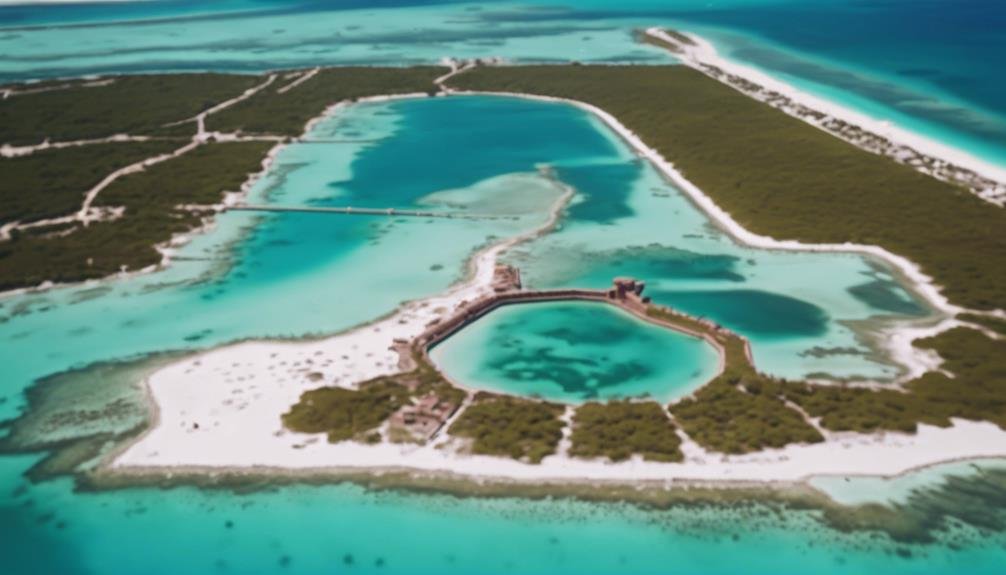
While the marine life at Dry Tortugas National Park is unquestionably mesmerizing, the park’s geography and geology offer equally intriguing insights. Located 70 miles west of Key West, Florida, this small archipelago primarily comprises coral islands.
These islands, formed from Pleistocene reef and oolitic limestone, create a unique and enthralling geological landscape. One of the most striking features is Fort Jefferson. This unfinished coastal fortress, constructed with over 16 million bricks, is the largest masonry structure in the Western Hemisphere.
The fort’s imposing presence is a tribute to human ingenuity and the islands’ historical importance throughout history. The park’s area is overwhelmingly aquatic, with over 99% of its expanse underwater. It’s bordered by the Florida Keys National Marine Sanctuary and the Tortugas Ecological Reserve, making it an essential part of a larger protected marine ecosystem.
The islands experience a tropical savanna climate characterized by a distinct rainy season from May to October. However, the park often faces drought-like conditions due to the lack of large forest canopy areas. Exploring Dry Tortugas National Park reveals a fascinating blend of natural and historical wonders, all set against pristine coral islands and azure waters.
Visitor Tips
Plan for transportation, activities, and accommodations to maximize your Dry Tortugas National Park visit. Since the park is 70 miles west of Key West and only accessible by boat or seaplane, booking your transportation in advance is essential. Once you’re there, the opportunities for adventure are endless, from snorkeling to exploring the historic Fort Jefferson. Here are some tips to enhance your experience:
- Book Early: Secure your boat or seaplane tickets well in advance, as they can sell out quickly, especially during peak seasons.
- Pack Wisely: If you plan to stay overnight, bring all necessary supplies, including food, water, and camping gear. The Garden Key campground has only eight primitive campsites, and they’re first-come, first-served.
- Explore the Fort: Don’t miss Fort Jefferson, a 19th-century coastal fortress. It’s a fascinating historical site and offers stunning views of the surrounding waters.
- Snorkeling Gear: Bring your gear to explore the vibrant coral reefs and diverse marine life. The park’s unique ecosystem, including patch reefs and branching coral rubble, makes for an unforgettable underwater adventure.
Conclusion
Dry Tortugas National Park is a hidden gem worth every bit of effort to reach. With its rich history at Fort Jefferson, vibrant coral reefs for snorkeling, serene beaches, and enchanting marine life, there’s something for everyone. Whether a history buff or a nature lover, this remote oasis offers a unique and unforgettable experience. Don’t miss the chance to explore this incredible blend of natural beauty and historical significance.
